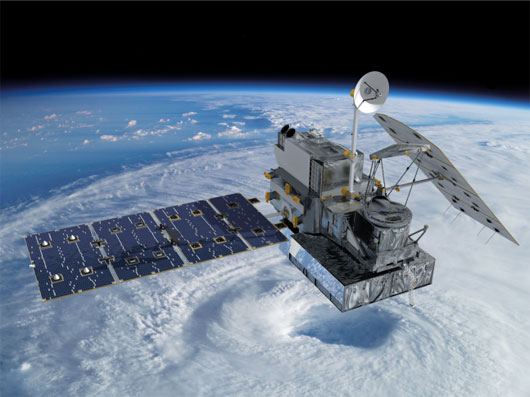New era for global meteorological observation system
A new type of satellite is designed to gather real-time information to measure rainfall, snowfall and storm forecasting on a global scale (GPM). This is the result of the project of the US space agency (NASA) and Japan (JAXA).
The project, which has been developed since 2005, has now been completed, is delivered to the Japanese side under the designation H-IIA and by the end of February this year it will be launched into the air from the Japanese Tanegashima Space Center.

New era for global meteorological observation system - (Photo: Gizmag)
Designed in accordance with the cooperation with the current satellites, GPM will fly at an altitude of 407km in an orbit 65 degrees above the equator, the data collected rain and snow will be transferred to the earth every time. Every 3 hours, so we will have a panorama of global rainfall.
GPM is the successor and development of the TRMM type of satellite operating since 1997 to measure tropical rainfall at different times of the day as well as tropical storms. GPM has proved to be much more advanced than the TRMM senior.
The sampling method of GPM satellites is similar to that of TRMM but with very modern devices such as radio micrometer, dual frequency radar, electronic cloud system to transmit information. Furthermore GPM sensors also collect data of snowfall and very small rains.
In addition, GPM also helps to monitor and forecast extreme weather events such as floods and storms.
Gizmag magazine said GPM was born on schedule and when launched into the air there will be 60 days to adjust and operate normally.
- Prepare to launch a global rainfall measuring satellite GPM
- Korea brought meteorological observation ships into use
- Japan is about to launch a global disaster observation satellite
- How the GPS system works
- Myanmar thanks Japan to launch a global observation satellite
- America will upgrade the global positioning system
- Europe launched 5 global observation satellites
- Setting up an earthquake observation station in the zoo
- Radio waves determine the meteorological services
- Observation tower towering in the middle of the Amazon forest
- Russia's global positioning system
- Successfully decode the signal Galileo global positioning satellite system
 Van Allen's belt and evidence that the Apollo 11 mission to the Moon was myth
Van Allen's belt and evidence that the Apollo 11 mission to the Moon was myth The levels of civilization in the universe (Kardashev scale)
The levels of civilization in the universe (Kardashev scale) Today Mars, the sun and the Earth are aligned
Today Mars, the sun and the Earth are aligned The Amazon owner announced a secret plan to build a space base for thousands of people
The Amazon owner announced a secret plan to build a space base for thousands of people Is alien life trying to contact Earth?
Is alien life trying to contact Earth?  Prepare to launch a global rainfall measuring satellite GPM
Prepare to launch a global rainfall measuring satellite GPM 